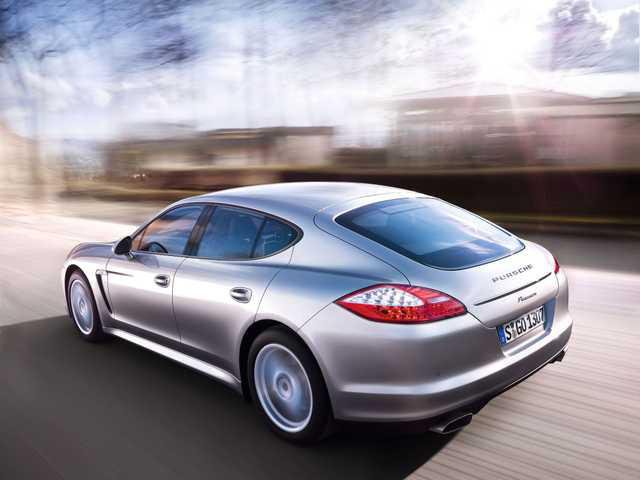No other luxury sedan tries to emulate a sports car as Porsche does with its Panamera. The Audi A8, Mercedes-Benz S-class, Lexus LS, Jaguar XJ, even the BMW 7-series are luxury sedans intended to take away the worries of the world with posh and comfortable performance.
The Panamera is posh, but it is more about the driving. The Panamera is a big car that brakes, turns and stops like a small car. At 3,880 pounds, it has a monocoque body built of steel, aluminum and magnesium. Six-piston, aluminum calipers clamp smoothly on front 14.15-inch discs; the rear 12.99-inch discs have four-piston calipers.
And these overkill specs are for the entry-level, Panamera V-6, a new addition for 2011, bringing the line to five models. Sold in rear- or all-wheel drive models, pricing starts at $75,375. All-wheel drive models start at $79,875.
But can a 300-hp, Panamera V-6 compare to the 400-hp Panamera S or the 500-hp Turbo? Not on a race track, but it does all right on the street.
The new 300-hp, 3.6-liter V-6 returns 18 mpg around town, 27 on the highway and will do 0-60 mph in 6 seconds, or 5.8 with the $1,440 Sport Chrono Package Plus. AWD, which adds just 132 pounds, drops the 0-60 time by .02 seconds at a cost of $4,500. And fuel economy is sacrificed by just 1 mpg highway.
Besides good Porsche engineering, such decent fuel economy can be credited to the engine's direct injection and a standard auto start-stop function of the engine. When making temporary stops, like at traffic lights, the engine switches off then restarts when the brake pedal is released. But auto-stop can vary according to the charge of the battery and how many cabin functions are being used. Until you get accustomed to the stop-start process, it can seem abrupt, but the savings in fuel and emissions are worth it, Porsche says.
This fall, Porsche will further address fuel economy and emissions by adding the 380-hp, Panamera S Hybrid, $95,975. It can be driven on battery power for up to a mile or use electric boost to assist the supercharged, 3.0-liter V-6 to make 0-60 mph in 5.7 seconds.
The Panamera seems bred to drive fast. At speed, the car seems to stretch out and tuck in. Steering lightens and all responses feel sharp and controlled. Dive into a corner, and the weight transfer is smile inducing as the rear end pulls through ... like a 911. Around town, the steering can feel heavy, particularly when parking.
The seven-speed Porsche PDK (Doppelkupplungsgetriebe) double-clutch, automated-manual transmission fires off immediate manual shifts. Soaring along winding roads, the Zen of man and machine is a bonding experience, but at times in town, the shifting can be hesitant. On good road surfaces, the ride quality is svelte, even when being pushed. But switch to rougher surfaces, and the ride feels like a stiff, 911 race car.
Not only does the Panamera look like a stretched 911, the cabin has a similar four-seat layout. Every occupant gets driver-seat like accommodations, minus the steering wheel. For the driver, the console layout of buttons and switches for audio, AC, suspension and performance controls will take a day or three to figure out and become comfortable.
The Panamera is not traditional, but it created a tradition. Last month, it outsold the 911 and Boxster-Cayman models, and now there is an ultimate 550-hp, Panamera Turbo S, with a starting price of $174,175.
Bred for speed: Porsche Panamera V-6


